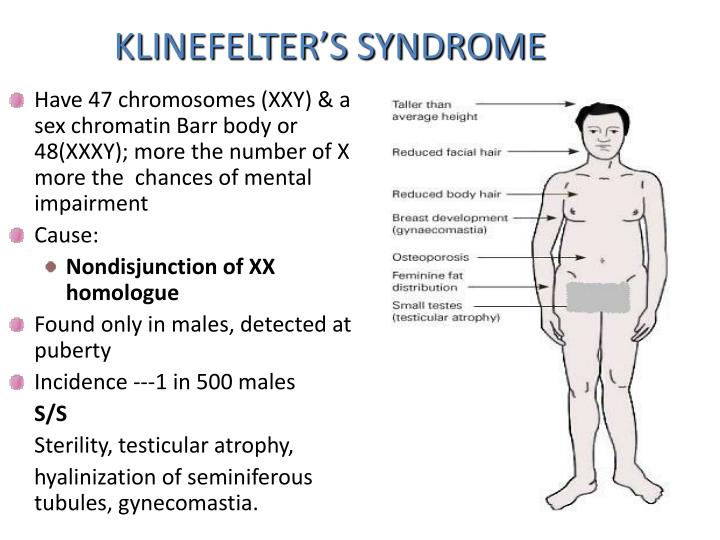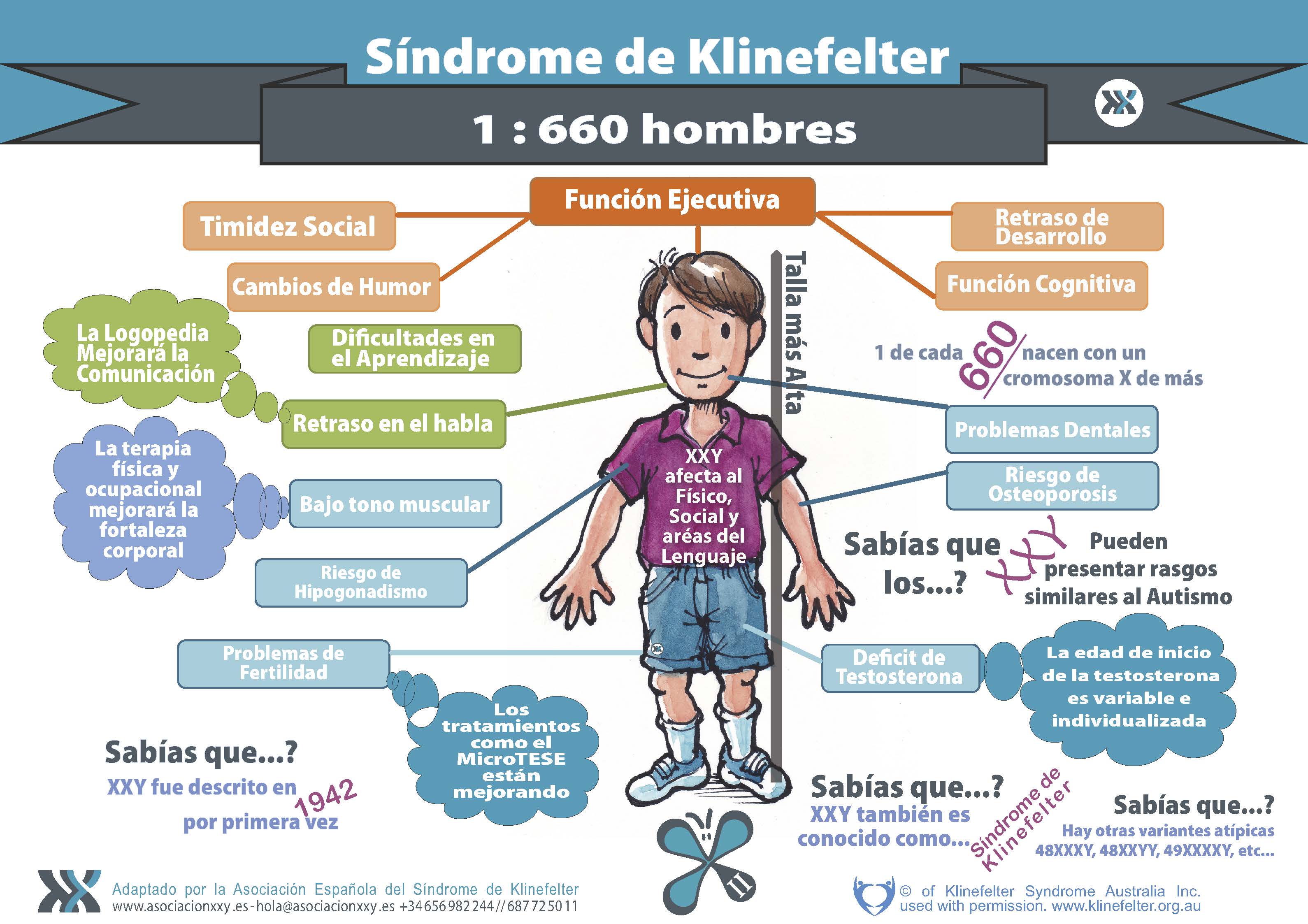Klinefelter syndrome, a genetic condition that affects only males, is a topic many people are curious about, and for good reason. It's a rather common occurrence, impacting individuals assigned male at birth when they have an extra copy of the X sex chromosome, instead of the typical XY pairing. This unique genetic setup, sometimes called 47,XXY, or even just XXY syndrome, really shapes how a person develops, both physically and in their thinking.
You know, understanding conditions like Klinefelter syndrome is quite important, especially when we consider its widespread presence. It affects about 1 in 650 male newborns, which makes it, you know, the most common sex chromosome disorder. This means it’s a big part of a group of conditions that come from changes in the number of sex chromosomes, like the X and Y chromosomes.
So, when people look for "Klinefelter XXY pictures," they are often trying to get a better sense of what this condition can mean for someone's appearance and overall well-being. It's about seeing beyond the genetic code to the human experience. Learning about its nature, how it might affect someone, and pathways to effective management and support can make a real difference, too, it's almost a way to connect with others.
Table of Contents
- What is Klinefelter Syndrome (XXY)?
- Common Physical and Developmental Aspects
- The Importance of Recognition and Support
- Frequently Asked Questions About Klinefelter XXY
- Moving Forward with Understanding
What is Klinefelter Syndrome (XXY)?
Klinefelter syndrome is a condition that, you know, comes from genetics. It affects only males, and it happens because a male is born with an extra X chromosome. Instead of the usual XY pair that most men have, a male with Klinefelter syndrome has XXY, which is a bit different, obviously.
This condition, sometimes called 47,XXY, is essentially a chromosome anomaly. It’s where a male has, you know, an extra X chromosome. It's quite a common genetic condition, as a matter of fact, and it’s something that can really influence both physical and mental development as a person grows.
So, to put it simply, Klinefelter syndrome means that a person assigned male at birth has, you know, this extra X sex chromosome. Most men are born with a pair of XY chromosomes, while most females are born with a pair of XX chromosomes. This extra X in males is what defines the condition, and it's something that, you know, makes it distinct.
Common Physical and Developmental Aspects
When we talk about Klinefelter syndrome, people often wonder about the physical traits and how it might affect a person's development. Symptoms can vary quite a bit, you know, but some common ones include breast growth, which is sometimes called gynecomastia. Infertility is also a very common feature, and it's actually considered a main characteristic of the syndrome, basically.
Beyond that, individuals with Klinefelter syndrome might experience osteoporosis, which is a condition where bones become weaker. Learning difficulties can also be part of the picture, affecting how someone processes information or learns new things. It’s pretty clear that these symptoms can, you know, show up in different ways for different people.
Complications that often come with Klinefelter syndrome include infertility, as mentioned, and also small, poorly functioning testicles, if they are present. These are aspects that can have, you know, a significant impact on a person's life. Other potential consequences include a micropenis, which is a smaller-than-average penis, and delayed puberty, where a person's body changes happen later than usual.
Subtle Signs and Their Impact
One of the interesting things about Klinefelter syndrome is that its outward signs can be quite subtle. This means that symptoms often, you know, are not recognized right away. Because of this, treatment might not be given in a timely manner, which can, you know, sometimes lead to more pronounced consequences later on.
It's important to remember that this condition describes a set of symptoms related to physical, language, and social development in males who have an extra X chromosome. So, it's not just about what you might see, but also about how someone communicates and interacts with others, which, you know, can be a bit different for them.
Understanding these subtle signs is a big part of knowing about Klinefelter syndrome. It helps in recognizing the condition earlier, which can then help with managing its various aspects. This focus on early recognition is, you know, very important for providing the best support possible.
Key Developmental Areas
The impact of Klinefelter syndrome stretches across several key areas of development. We've talked about physical development, but it also affects mental development, which can show up as learning difficulties. These difficulties can range, you know, and might require specific support to help individuals thrive.
Language development can also be influenced, meaning some individuals might have challenges with speaking or understanding language. This is part of the broader set of symptoms that relate to communication. Social development is another area that can be affected, influencing how individuals interact and form relationships, which, you know, is pretty fundamental to life.
So, when we consider the full picture of Klinefelter syndrome, it's about looking at these interconnected areas of physical, mental, language, and social development. Understanding how the extra X chromosome shapes these aspects helps us to, you know, provide more comprehensive support and care for those living with the condition.
The Importance of Recognition and Support
Recognizing Klinefelter syndrome early and getting appropriate treatment is, you know, very important. This helps a lot in preventing or managing its various consequences. Think about things like micropenis, learning disabilities, delayed puberty, infertility, and osteoporosis; addressing these early can make a real difference in someone's life, that is for sure.
For example, knowing about the possibility of delayed puberty means that support can be offered to help with this transition. If learning disabilities are identified early, educational strategies can be put in place to help a child succeed in school. This proactive approach is, you know, truly beneficial.
It’s about understanding the nature of Klinefelter syndrome, its potential impact, and finding pathways to effective management and support. This could involve medical treatments, therapies, or just, you know, a strong support system. The goal is to help individuals with Klinefelter syndrome live full and healthy lives, which is what everyone deserves, anyway.
We believe in sharing what you should know about the causes, the symptoms, and the treatment options for this condition. It's about empowering individuals and their families with information. For more detailed information and support resources, you might want to visit a reputable health organization. You can also learn more about on our site, and find additional resources on this page .
Frequently Asked Questions About Klinefelter XXY
Q1: What does Klinefelter syndrome typically look like?
While "Klinefelter XXY pictures" might suggest a very specific appearance, the outward signs of Klinefelter syndrome can actually be quite subtle. Individuals might have taller stature, and some may experience breast growth, which is a common physical aspect. Other signs might include smaller testicles, and in some cases, a less developed body hair pattern compared to other males. It really varies from person to person, you know, and sometimes the physical differences are not immediately obvious.
Q2: How common is Klinefelter syndrome?
Klinefelter syndrome is, you know, a fairly common genetic condition. It affects about 1 in 650 male newborns. This makes it the most common sex chromosome disorder, which is a group of conditions that happen because of changes in the number of sex chromosomes. So, it's something that, you know, affects a good number of people, more or less, across the population.
Q3: What are the main challenges for someone with Klinefelter syndrome?
The main challenges for someone with Klinefelter syndrome can include infertility, which is often a significant concern. Learning difficulties, delayed puberty, and osteoporosis are also common complications. Additionally, some individuals might experience challenges with language and social development. The impact really varies, you know, and recognizing these challenges early can help a lot with providing support and treatment.
Moving Forward with Understanding
Exploring Klinefelter syndrome, a common genetic variation affecting males, helps us to, you know, really grasp its nature and its wide-ranging impact. Understanding this condition is about more than just knowing the facts; it's about appreciating the pathways to effective management and support that are available today.
The journey for individuals with Klinefelter syndrome, and their families, is often about seeking information and finding the right kind of help. This means looking into causes, understanding the symptoms, and exploring all the treatment options that exist. It’s about being informed and empowered, which is, you know, pretty essential for anyone dealing with a genetic condition.
So, as we continue to learn more about Klinefelter syndrome, the focus remains on supporting those affected. It’s about ensuring that recognition leads to timely treatment, and that resources are there to help prevent or manage the various consequences, like micropenis or learning disabilities. It's a continuous effort to provide care and understanding, anyway.



Detail Author:
- Name : Mike Carroll
- Username : astehr
- Email : lela.hodkiewicz@hotmail.com
- Birthdate : 1986-03-26
- Address : 5801 Brett Locks Apt. 725 South Clark, CT 21102
- Phone : +1-463-221-4110
- Company : Cruickshank, Douglas and Gleichner
- Job : Material Moving Worker
- Bio : Ut ullam modi eveniet neque eos occaecati. Esse quis ex beatae tempora est. Esse rerum autem ea qui rem. Quaerat unde laudantium qui tempore possimus ad ad fugit.
Socials
linkedin:
- url : https://linkedin.com/in/strosin2018
- username : strosin2018
- bio : Ad est consequatur quaerat non minus et libero.
- followers : 889
- following : 1898
twitter:
- url : https://twitter.com/strosino
- username : strosino
- bio : Dolor ipsam repudiandae velit a nesciunt. Error aperiam voluptatem consequuntur ducimus dolorem itaque. Vero cum est ex aut.
- followers : 4995
- following : 1915
facebook:
- url : https://facebook.com/ofeliastrosin
- username : ofeliastrosin
- bio : Quia tempore qui dignissimos animi.
- followers : 4727
- following : 2567
tiktok:
- url : https://tiktok.com/@ofelia_strosin
- username : ofelia_strosin
- bio : Et sed sit consequatur et. Possimus et et nihil ut quas pariatur.
- followers : 1525
- following : 2802
instagram:
- url : https://instagram.com/strosin2014
- username : strosin2014
- bio : Quae quas et debitis saepe. Saepe sint aut dicta quas. Non iste eaque incidunt odit omnis.
- followers : 3113
- following : 959